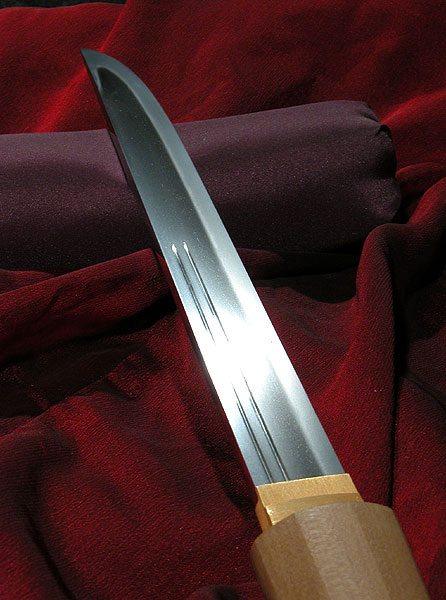For those interested in the Japanese sword, most know the name of Yoshindo Yoshihara. He is a Mukansa smith who has done more than any other Japanese smith to help bring good information to the US about Japanese swords, the crafts, etc. In part due to his collaboration with the Kapp's (Leon and Hiroko) on two very good books, but also due to his willingness to travel to the US, do demonstrations, answer questions, etc. So most know his name and he is arguably the most famous Japanese smith in the US today.
Most don't know that he has a brother, Shoji, who is also a renowned smith. Some will sit around and argue over who is better, actually, as both men have very distinctive styles. Nonetheless, both are up there at the top of the heap, so to speak, and their work is highly prized.
Anyway, the reason I bring this up is a good friend of mine is helping sell a set of swords. What is very cool about it is that the daito (long sword) was actually made by both brothers and signed by both back before they were "mukansa" smiths (meaning beyond contests). And the blade was in fact forged in Dallas during a long demonstration on crafts. Some swords from that demonstration years ago went to various museums. This one went to a private collector who had long collected work by these men. So here's a sword jointly made by the two brothers, a very unusual thing indeed.
Another quite unusual thing is the way the daito was finished. It is a fairly typical exuberant Bizen style blade -- choji midare ("clove bud" shaped hamon), itame hada (fine wood grain), in nioi (very fine small misty structure). Normally blades like this are finished in a style called kesho -- or "make up" polish. The hamon is grouped and sort of outlined. This is done in part because it is *very* difficult to do a sashikomi finish that does a sword like this justice simply due to the nature of the finishing and getting very fine fingerstones in between those little buds (without wiping out all the other stuff you're trying to keep). Anyway, this blade is finished sashikomi and is virtually a perfect polish. The lines are super crisp, the blade amazingly shaped, the tip... Well, let's just say I spent days studying the tip on this sword (since I was doing the photography I had the blades for about a month -- it was hard giving them back).
Regardless, there is also a tanto and kogatana by Yoshindo Yoshihara in the set. Each blade is very different, and each is finished differently. Each presented me with days of learning experience studying the work, the polish, the forging, everything.
Obviously these is nothing I could afford to buy myself. And such swords are out of reach of most everyone but the wealthiest of collectors. But the photos are up on Ted's site right now and there are lots of them. Good stuff to learn from if you're into this craft. Good stuff to see if you're into Japanese swords. Heck, the habaki (blade collar) on the tanto in the set is made of two interlocking pieces of solid gold. I spend hours just measuring, studying, and trying to understand just that one part.
The photos are on Ted Tenold's site, http://www.legacyswords.com . Click on the swords then select antiques. Really good, educational stuff there in the photos and description. Kinda cool to see history like this. Especially considering these pieces were made before the brothers were famous, big stars of the sword world.

